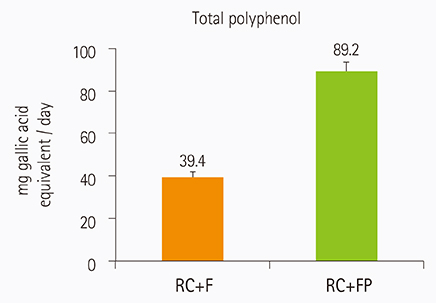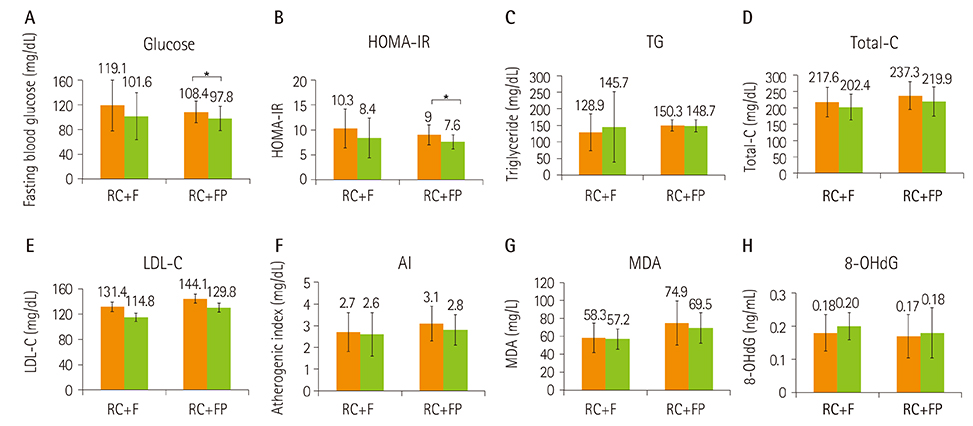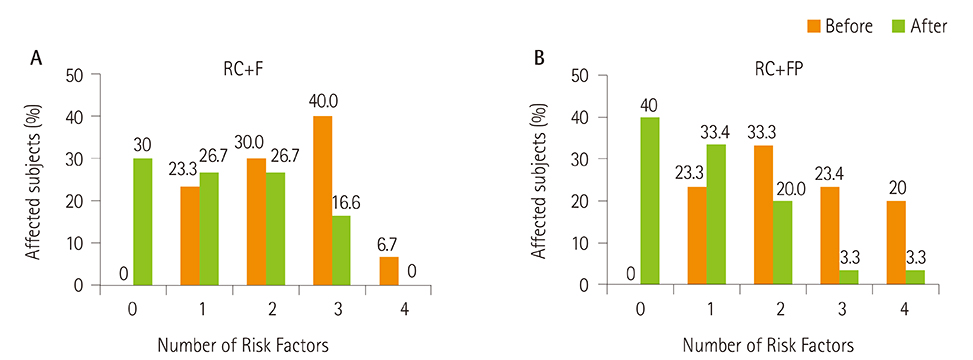Clin Nutr Res.
2016 Apr;5(2):79-88. 10.7762/cnr.2016.5.2.79.
Rice Cakes Containing Dietary Fiber Supplemented with or without Artemisia Annua and Gynura Procumbens Merr. Alleviated the Risk Factors of Metabolic Syndrome
- Affiliations
-
- 1Department of Food and Nutrition, College of Human Ecology, Yonsei University, Seoul 03722, Korea. leeseungmin@yonsei.ac.kr
- KMID: 2168225
- DOI: http://doi.org/10.7762/cnr.2016.5.2.79
Abstract
- We investigated whether the consumption of Korean rice cakes enriched with dietary fiber with or without polyphenol rich plants might decrease the risk factors of metabolic syndrome (MetS). Rice cakes were manufactured using fructooligosaccharides, resistant starch, and psyllium as sources of dietary fibers with and without polyphenol rich Artemisia annua and Gynura procumbens Merr. (RC+FP and RC+F, respectively), and prepared in three forms (songpyeon, seolgidduk, and chaldduk). Ninety subjects with at least one MetS risk factor were recruited for 6 weeks of dietary intervention. Sixty subjects were finally included for the analysis. Compared to the initial values, RC+FP group had decreased levels of fasting blood glucose (FBG), HOMA-IR and blood pressure after 6 weeks, whereas RC+F group didn't have significant changes in them. Regarding the improvement of individual MetS risk factors, RC+FP group showed significant reduction in FBG and blood pressures but RC+F group only had reduction in systolic blood pressure. After the intervention, a reduction in the number of MetS risk factors was greatert in the RC+FP group than in the RC+F group. In conclusion, Dietary fiber enriched rice cakes with or without polyphenols decreased the number and/or the levels of MetS risk factors. Polyphenol rich plant components may provide additional health benefits in controlling FBG and blood pressure.
MeSH Terms
Figure
Reference
-
1. Riccardi G, Rivellese AA. Dietary treatment of the metabolic syndrome--the optimal diet. Br J Nutr. 2000; 83:Suppl 1. S143–S148.2. Korea Centers for Disease Control and Prevention. In-depth analyses of the third national health and nutrtion examination survey: the health interview and health behavior survey part. Seoul: Korea Centers for Disease Control and Prevention;2007.3. Sloth B, Krog-Mikkelsen I, Flint A, Tetens I, Björck I, Vinoy S, Elmståhl H, Astrup A, Lang V, Raben A. No difference in body weight decrease between a low-glycemic-index and a high-glycemic-index diet but reduced LDL cholesterol after 10-wk ad libitum intake of the low-glycemic-index diet. Am J Clin Nutr. 2004; 80:337–347.
Article4. Sierra M, García JJ, Fernández N, Diez MJ, Calle AP. Therapeutic effects of psyllium in type 2 diabetic patients. Eur J Clin Nutr. 2002; 56:830–842.
Article5. Tucker LA, Thomas KS. Increasing total fiber intake reduces risk of weight and fat gains in women. J Nutr. 2009; 139:576–581.
Article6. Wismar R, Brix S, Frøkiaer H, Laerke HN. Dietary fibers as immunoregulatory compounds in health and disease. Ann N Y Acad Sci. 2010; 1190:70–85.
Article7. Lerman RH, Minich DM, Darland G, Lamb JJ, Schiltz B, Babish JG, Bland JS, Tripp ML. Enhancement of a modified Mediterranean-style, low glycemic load diet with specific phytochemicals improves cardiometabolic risk factors in subjects with metabolic syndrome and hypercholesterolemia in a randomized trial. Nutr Metab (Lond). 2008; 5:29.
Article8. Ma Y, Griffith JA, Chasan-Taber L, Olendzki BC, Jackson E, Stanek EJ 3rd, Li W, Pagoto SL, Hafner AR, Ockene IS. Association between dietary fiber and serum C-reactive protein. Am J Clin Nutr. 2006; 83:760–766.
Article9. Hlebowicz J, Darwiche G, Björgell O, Almér LO. Effect of cinnamon on postprandial blood glucose, gastric emptying, and satiety in healthy subjects. Am J Clin Nutr. 2007; 85:1552–1556.
Article10. Park MA, Lee JW, Shin MS, Ly SY. Glycemic index lowering effects of breads supplemented with resistant starch, whole rye grain and fructooligosaccharide. Korean J Community Nutr. 2007; 12:189–197.11. Yamada Y, Hosoya S, Nishimura S, Tanaka T, Kajimoto Y, Nishimura A, Kajimoto O. Effect of bread containing resistant starch on postprandial blood glucose levels in humans. Biosci Biotechnol Biochem. 2005; 69:559–566.
Article12. Alberti KG, Zimmet P, Shaw J. Metabolic syndrome—a new world-wide definition A consensus statement from the international diabetes federation. Diabet Med. 2006; 23:469–480.
Article13. Korea Food & Drug Administration. Food safety standard code. Seoul: Korea Food & Drug Administration;2015.14. Rural Development Administration (KR). Standard food composition table. 8th rev. ed. Paju: Kyomunsa;2012.15. Haglund O, Luostarinen R, Wallin R, Wibell L, Saldeen T. The effects of fish oil on triglycerides, cholesterol, fibrinogen and malondialdehyde in humans supplemented with vitamin E. J Nutr. 1991; 121:165–169.
Article16. Matthews DR, Hosker JP, Rudenski AS, Naylor BA, Treacher DF, Turner RC. Homeostasis model assessment: insulin resistance and beta-cell function from fasting plasma glucose and insulin concentrations in man. Diabetologia. 1985; 28:412–419.
Article17. The Korean Nutrition Society. Dietary reference intakes for Koreans. 1st rev. ed. Seoul: The Korean Nutrition Society;2010.18. Shin D. Analysis of dietary insoluble and soluble fiber contents in school meal. Nutr Res Pract. 2012; 6:28–34.
Article19. Whelton SP, Hyre AD, Pedersen B, Yi Y, Whelton PK, He J. Effect of dietary fiber intake on blood pressure: a meta-analysis of randomized, controlled clinical trials. J Hypertens. 2005; 23:475–481.
Article20. Streppel MT, Arends LR, van't Veer P, Grobbee DE, Geleijnse JM. Dietary fiber and blood pressure: a meta-analysis of randomized placebo-controlled trials. Arch Intern Med. 2005; 165:150–156.21. Poh TF, Ng HK, Hoe SZ, Lam SK. Gynura procumbens causes vasodilation by inhibiting angiotensin II and enhancing bradykinin actions. J Cardiovasc Pharmacol. 2013; 61:378–384.
Article22. Kim MJ, Lee HJ, Wiryowidagdo S, Kim HK. Antihypertensive effects of Gynura procumbens extract in spontaneously hypertensive rats. J Med Food. 2006; 9:587–590.
Article23. Hannan JM, Ali L, Khaleque J, Akhter M, Flatt PR, Abdel-Wahab YH. Aqueous extracts of husks of Plantago ovata reduce hyperglycaemia in type 1 and type 2 diabetes by inhibition of intestinal glucose absorption. Br J Nutr. 2006; 96:131–137.
Article24. Yu LL, Lutterodt H, Cheng Z. Beneficial health properties of psyllium and approaches to improve its functionalities. Adv Food Nutr Res. 2008; 55:193–220.25. Kim HS, Kim TW, Kim DJ, Kim KK, Choe M. Effects of medicinal plant water extracts on expression of anti-diabetic enzymes mRNA. J Korean Soc Food Sci Nutr. 2013; 42:1008–1014.
Article26. Hassan Z, Yam MF, Ahmad M, Yusof AP. Antidiabetic properties and mechanism of action of Gynura procumbens water extract in streptozotocin-induced diabetic rats. Molecules. 2010; 15:9008–9023.
Article27. Al-Waili NS. Treatment of diabetes mellitus by Artemisia herba-alba extract: preliminary study. Clin Exp Pharmacol Physiol. 1986; 13:569–573.
Article28. Twaij HA, Al-Badr AA. Hypoglycemic activity of Artemisia herba alba. J Ethnopharmacol. 1988; 24:123–126.
Article29. Ferreira JF, Luthria DL, Sasaki T, Heyerick A. Flavonoids from Artemisia annua L. as antioxidants and their potential synergism with artemisinin against malaria and cancer. Molecules. 2010; 15:3135–3170.
Article30. Melillo de Magalhães P, Dupont I, Hendrickx A, Joly A, Raas T, Dessy S, Sergent T, Schneider YJ. Anti-inflammatory effect and modulation of cytochrome P450 activities by Artemisia annua tea infusions in human intestinal Caco-2 cells. Food Chem. 2012; 134:864–871.
Article31. Kishida T, Nogami H, Himeno S, Ebihara K. Heat moisture treatment of high amylose cornstarch increases its resistant starch content but not its physiologic effects in rats. J Nutr. 2001; 131:2716–2721.
Article32. Ranhotra GS, Gelroth JA, Glaser BK. Effect of resistant starch on blood and liver lipids in hamsters. Cereal Chem. 1996; 73:176–178.33. Yamashita K, Kawai K, Itakura M. Effects of fructo-oligosaccharides on blood glucose and serum lipids in diabetic subjects. Nutr Res. 1984; 4:961–966.
Article
- Full Text Links
- Actions
-
Cited
- CITED
-
- Close
- Share
- Similar articles
-
- What is In-Jin-Sook? Artemisia capillaris, Artemisia iwayomogi, and Artemisia annua
- Inhibitory Effects of an Aqueous Extract of Gynura procumbens on Human Mesangial Cell Proliferation
- Seizure Induction by Artemisia Annua in an Epilepsy Patient Taking Levetiracetam
- High fiber and high carbohydrate intake and its association with the metabolic disease using the data of KNHANES 2013 ~ 2017
- Gynura procumbens extract improves insulin sensitivity and suppresses hepatic gluconeogenesis in C57BL/KsJ-db/db mice






